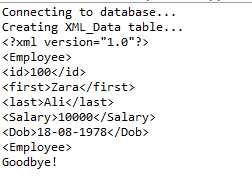JDBC的流數據
阿新 • • 發佈:2017-06-13
employee example 存儲 while integer update ins state into
以下內容引用自http://wiki.jikexueyuan.com/project/jdbc/streaming-data.html:
PreparedStatement對象必須具備使用輸入和輸出流來提供參數數據的能力。這能夠將整個文件存儲到數據庫列中,這樣數據庫就能存儲大型數據,例如CLOB和BLOB數據類型。
用於流數據有下列幾種方法:
- setAsciiStream():該方法是用來提供較大的ASCII值。
- setCharacterStream():該方法是用來提供較大的UNICODE值。
- setBinaryStream():該方法是用來提供較大的二進制值。
setXXXStream()方法需要一個額外的參數,該參數是除了參數占位符的文件大小。這個參數通知驅動程序通過使用流有多少數據被發送到數據庫中。
示例:
假要上傳一個名為XML_Data.xml的XML文件到數據庫的表中。下面是該XML文件的內容:
<?xml version="1.0"?> <Employee> <id>100</id> <first>Zara</first> <last>Ali</last> <Salary>10000</Salary> <Dob>18-08-1978</Dob> <Employee>
將該XML文件和要運行的示例保存在相同的目錄的。
這個示例將創建一個數據庫表XML_Data,然後XML_Data.xml將被上傳到該表中。
將下面的示例拷貝並粘帖到JDBCExample.java中,編譯並運行它,如下所示:
//Import required packages import java.sql.*; import java.io.*; import java.util.*; public class JDBCExample { // JDBC driver name and database URL static final String JDBC_DRIVER = "com.mysql.jdbc.Driver"; static final String DB_URL = "jdbc:mysql://localhost/Test?serverTimezone=UTC";// Database credentials static final String USER = "root"; static final String PASS = "root"; public static void main(String[] args) { Connection conn = null; PreparedStatement pstmt = null; Statement stmt = null; ResultSet rs = null; try { // Register JDBC driver Class.forName("com.mysql.jdbc.Driver"); // Open a connection System.out.println("Connecting to database..."); conn = DriverManager.getConnection(DB_URL, USER, PASS); // Create a Statement object and build table stmt = conn.createStatement(); createXMLTable(stmt); // Open a FileInputStream File f = new File("XML_Data.xml"); long fileLength = f.length(); FileInputStream fis = new FileInputStream(f); // Create PreparedStatement and stream data String SQL = "INSERT INTO XML_Data VALUES (?,?)"; pstmt = conn.prepareStatement(SQL); pstmt.setInt(1, 100); pstmt.setAsciiStream(2, fis, (int) fileLength); pstmt.execute(); // Close input stream fis.close(); // Do a query to get the row SQL = "SELECT Data FROM XML_Data WHERE id=100"; rs = stmt.executeQuery(SQL); // Get the first row if (rs.next()) { // Retrieve data from input stream InputStream xmlInputStream = rs.getAsciiStream(1); int c; ByteArrayOutputStream bos = new ByteArrayOutputStream(); while ((c = xmlInputStream.read()) != -1) bos.write(c); // Print results System.out.println(bos.toString()); } // Clean-up environment rs.close(); stmt.close(); pstmt.close(); conn.close(); } catch (SQLException se) { // Handle errors for JDBC se.printStackTrace(); } catch (Exception e) { // Handle errors for Class.forName e.printStackTrace(); } finally { // finally block used to close resources try { if (stmt != null) stmt.close(); } catch (SQLException se2) { } // nothing we can do try { if (pstmt != null) pstmt.close(); } catch (SQLException se2) { } // nothing we can do try { if (conn != null) conn.close(); } catch (SQLException se) { se.printStackTrace(); } // end finally try } // end try System.out.println("Goodbye!"); }// end main public static void createXMLTable(Statement stmt) throws SQLException { System.out.println("Creating XML_Data table..."); // Create SQL Statement String streamingDataSql = "CREATE TABLE XML_Data " + "(id INTEGER, Data LONG)"; // Drop table first if it exists. try { stmt.executeUpdate("DROP TABLE XML_Data"); } catch (SQLException se) { } // do nothing // Build table. stmt.executeUpdate(streamingDataSql); }// end createXMLTable }// end JDBCExample
當運行JDBCExample時,它將展示下面的結果:

測試工程:https://github.com/easonjim/5_java_example/tree/master/jdbcbasics/test9
JDBC的流數據
